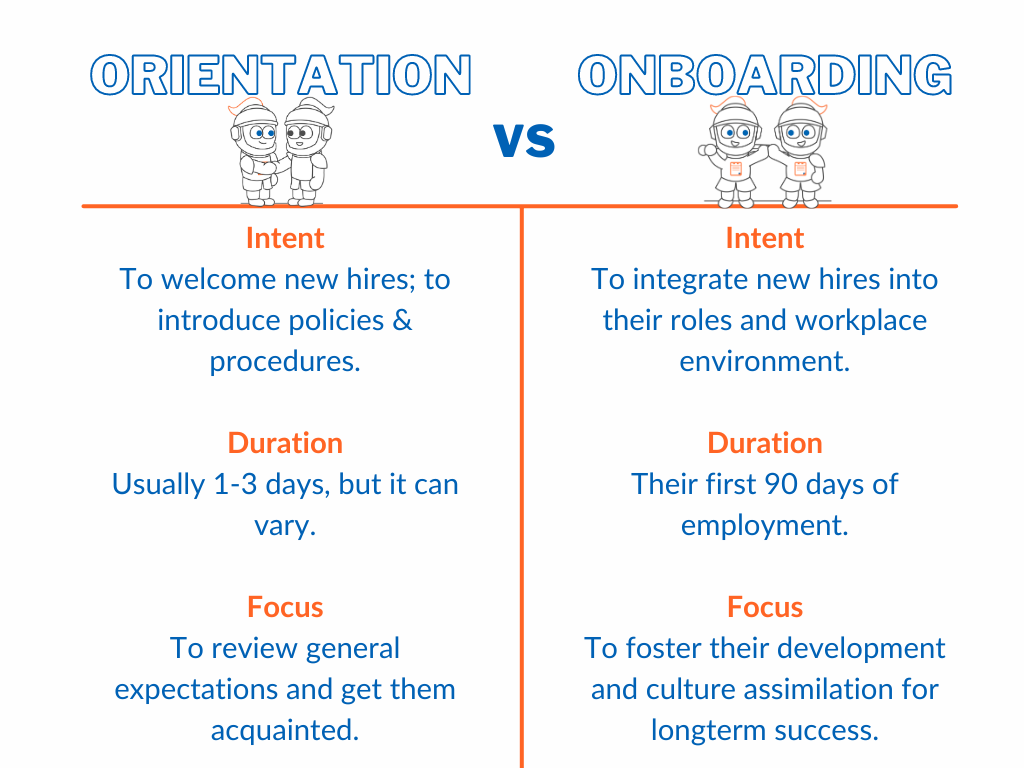A quick ramp-up can eliminate buyer’s remorse – and a great onboarding process can help!
Picture this: you’ve just hired a total superstar and you’re excited to see how they contribute to your growing business.
On their first day, you hand them a laptop and give them a high-five.
You then send them to their desk with a list of training tasks and do an informal check-in whenever it crosses your mind.
…but after a few months, you realize their performance isn’t what you expected. Soon after, they quit.

Why?
Chances are, they felt confused or disappointed due to the lack of support and direction they received.
Failing to onboard employees effectively will trap you in a neverending cycle of hiring, onboarding, and exits or terminations.
This can be costly and stressful – your turnover rates will be less than satisfactory, and your entire business could be impacted.
To retain great hires, you can certainly start with a laptop and a high-five, but you need to set them up for success by having a process to help them integrate into their roles.
Onboarding is pivotal – you need to get it right and exceed their expectations during their first 90 days of employment.
At Castle HR, we like to help our clients shift their focus from finding great talent to ramping them up so they can become successful, valuable members of your team!
With the right onboarding process, you can ensure your new hires feel valued and supported, increasing productivity and employee retention. Keep reading to learn how you can make this possible!
*Throughout this blog, you’ll notice that we refer to the onboarding process as a Modern Onboarding Playbook. This is a part of our service offering at Castle HR.
Why Is Onboarding Important?
First impressions matter – onboarding welcomes and integrates new individuals into your organization and, if done well, should set them up for success!
Onboarding should provide essential information, resources, and support to help your new hires adapt to their roles and surroundings effectively.
Through a well-structured onboarding process, individuals can quickly understand their responsibilities, develop positive relationships with colleagues, and adjust to their company culture and routines.
Successful onboarding ensures a smoother transition, boosts productivity and enhances employee satisfaction, ultimately contributing to the long-term success of both the individual and the organization.
Onboarding is important because without it, you risk lost profits, low productivity, low morale, and high turnover rates.
What Is The Difference Between Orientation and Onboarding?
One big misconception is that the terms ‘orientation’ and ‘onboarding’ can be used interchangeably. While both can co-occur, orientation and onboarding are not the same.

Orientation is a short-term event, usually occurring during the initial days or first week of joining an organization.
Its primary purpose is to provide basic information about policies, procedures, day-to-day operations and company expectations. There may even be icebreakers or a few games to welcome new hires.
Onboarding is a comprehensive and ongoing process (90 days).
The purpose of onboarding is to integrate new hires, get them comfortable and confident in their roles, and set them up for a successful and productive future at your company.
What Is An Onboarding Process?
An onboarding process is the actions and steps you take to ensure a new hire is integrated and acclimated to their new role at your company.
This process (or plan, strategy, playbook, etc.) should span over each new hire’s first 90 days and be detailed enough to ensure they’ll have everything they need to succeed at your organization.
As we said earlier, this goes beyond a laptop and a high-five!
Most companies do well with orientation, but what’s beyond those first few days matters the most.
When onboarding a new team member, you must always consider the following:
- Company values, mission and culture – to keep your business thriving, everyone on your team must align with your values and culture; culture can be a KPI and, thus, should always be a component of probation and performance reviews!
- Role expectations – these can be derived from job descriptions and clearly explained/revisited when evaluating the individual.
- Goals for the new employee’s first 90 days – set some attainable ones to reference during the probation review to ensure they’re ramping up as expected!
- Company policies and procedures – these should be reviewed during orientation and be easy to access (for instance, using an online platform that the employee has ongoing access to, or in your employee handbook) so that the new hire can reference them as needed.
- Important HR information – this can be digitalized as well and should be easy to access so that everyone on your team knows how to contact HR, book time off, etc.
- Probation review – if onboarding is done well, this should be a conversation about their growth; you can reference their goals, value alignment and overall progress since day 1.
- Employee Referral Program – if you’ve secured an A-Player who ramped up quickly and align with your values, chances are, they have friends and former colleagues who may be valuable assets to your team.
What Are The Benefits Of Having An Onboarding Process?
A strategic onboarding process offers numerous advantages for employers and employees alike!
Here are some of the benefits you can expect:
Accelerated ramp-up time
A well-structured onboarding playbook ensures new hires get up to speed faster, allowing them to contribute to team success more quickly.
Happy, motivated employees
You only have one shot at harnessing that ‘new hire energy.’

When you make a great first impression, your newest hires will remain motivated, happy, and confident as they begin to learn their role and settle in as a member of the team.
Enhanced productivity
An effective onboarding process can significantly improve new hire productivity, resulting in better business outcomes.
Improved employee retention
~20% of employee turnover happens in the first 45 days.
…by providing a positive onboarding experience, you can increase new hire retention rates and reduce the risk of early turnover!
Consistent and scalable onboarding process
Standardizing your onboarding approach is essential, making it easier to replicate and scale as your company grows.
A repeatable, proven process will make fast ramp-up and good retention rates possible and the onboarding process much less stressful for leaders.
Best Practices for Successful Employee Onboarding
Implementing best practices in your onboarding process can lead to greater engagement and success. Consider the following strategies:
Pre-boarding communication: Establish communication channels to connect with new hires before their start date, sharing important information and making them feel welcome and less overwhelmed on their first day.
Personalized onboarding experiences: Tailor the onboarding process to meet the unique needs of each employee, considering their role, department, and career goals.
Assigning mentors or buddies: Pair new hires with experienced employees who can provide guidance, answer questions, and support their integration into the company.
Ongoing feedback and check-ins: Schedule regular check-ins to provide constructive feedback, address concerns, and ensure new hires are on track to meet their goals. This is also where quarterly Modern Performance Reviews can help you address concerns early and stay in the loop with all employees, including your newest team members!
Continuous learning and development: Offer opportunities for professional growth through training, workshops, and access to learning resources to foster a culture of continuous improvement.
Digitalize and automate your processes: This will improve efficiency and save time for all! By providing access to training materials, company policies and procedures, and other resources through a single online portal (for example), you can reduce the amount of time and effort required from leaders, HR and other team members while also ensuring that new hires have everything they need to succeed at their fingertips!
* At Castle HR, we help our clients with their onboarding processes by developing and implementing Modern Onboarding Playbooks. We also incorporate their playbooks into their HRIS/ HR Tech Stack for a seamless, repeatable onboarding process!
How to Measure Onboarding Success
Tracking and measuring the success of your onboarding program is essential for continuous improvement.

You can use several metrics to measure the success of your onboarding program, including employee retention rates, time-to-productivity, and employee engagement scores.
By tracking these metrics over time, you can identify areas for improvement and make adjustments to your onboarding process/Modern Onboarding Playbook as needed!
An effective way to keep track of progress and keep everything (and everyone) moving smoothly in the right direction is by conducting team surveys and Modern Performance Reviews.
Conversations about their trajectories and goals, as well as any feedback from your team, is a great way to get a sense of your current onboarding process’ impact!
How to Overcome Onboarding Challenges
Onboarding can present unique challenges. One common mistake business owners make is failing to have a repeatable and easy-to-navigate onboarding process.
Potential issues can include:
Information overload
We recommend you break down information into manageable chunks and provide ongoing access to resources to prevent overwhelming new hires. An overwhelmed employee may not acclimate to their role successfully or stay for very long.
Lack of clarity and expectations
Clearly define roles, responsibilities, and performance expectations from the outset to minimize confusion and promote accountability. This goes back to your Talent Acquisition strategy (specifically your job description).

Limited social integration
Nobody likes participating in an uncomfortable amount of ice-breakers…but on the flip side, many remote and hybrid teams face a lack of social integration.
At Castle HR, our team utilizes Slack and Google Meets. We have a Buddy Program in place for each of our new hires, and we even initiate regular social calls where our team members are paired together at random for half an hour to chat (this goes on beyond onboarding, too).
Insufficient feedback and support
Establish regular check-ins, feedback loops, and mentorship programs to ensure new hires receive guidance and support. If your new hire is having trouble (with their deliverables or even a social aspect of the job), they should know where to turn.
The process of hiring, ramping up, and fostering the growth of a new team member can present challenges – and the last thing you want is for them to quit due to lack of clarity, support, or social integration.
That’s why investing in your onboarding process is critical.
How Can Castle HR Help With Your Onboarding Process?
The first 90 days of employment are vital, as an onboarding process can make or break the experience for new talent on your team!
You now know several benefits to having a well-established onboarding process and that specific inclusions can make or break the first impression you make on your new hires.
At Castle HR, we help our clients build their Modern Onboarding Playbook, and we help with automation and incorporating the process into their HRIS.
This means you’ll have a repeatable process that clearly outlines your expectations of your newest team members and makes the entire process stress-free for all parties involved.
We can help you establish the best onboarding process for your business, which typically includes other components, like probation and Modern Performance Reviews, surveys, and even Employee Referral Programs to contribute to a successful and repeatable onboarding process!
Ready to chat? Book a call with us today.

Lyndsy has been working in the HR realm for over two years and has experience in content management, ghostwriting and copywriting. She holds a Bachelor’s in English and Cultural Studies and considers herself a lifelong learner and passionate storyteller. Regarding modern HR, Lyndsy believes businesses can stand out as ‘top destinations’ for talented people by adopting a people-centred approach and fostering a strong culture; that’s one of the reasons she was drawn to Castle HR!